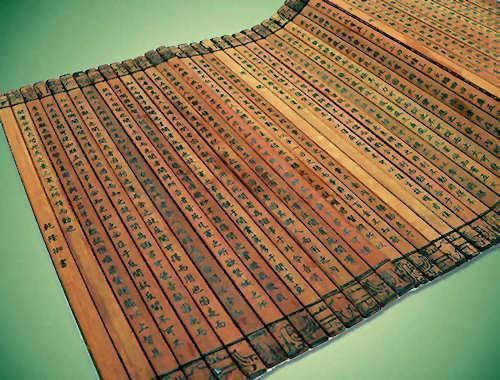Original title 竹書紀年 Publication date before 296 BC | Countries Wei, History of China | |
 | ||
Country State of Wei, ancient China Subject ancient Chinese history Similar Book of Documents, Records of the Grand Historian, Classic of Filial Piety, Spring and Autumn Annals, Zuo zhuan | ||
The Bamboo Annals (Chinese: 竹書紀年; pinyin: Zhúshū Jìnián), also known as the Ji Tomb Annals (Chinese: 汲冢紀年; pinyin: Jí zhǒng jìnián), is a chronicle of ancient China. It begins at the earliest legendary times (the Yellow Emperor) and extends to 299 BC, with the later centuries focusing on the history of the State of Wei in the Warring States period. It thus covers a similar period to Sima Qian's Records of the Grand Historian (91 BC). The original may have been lost during the Song dynasty, and the text is known today in two versions, a "current text" (or "modern text") of disputed authenticity and an incomplete "ancient text".
Contents
Textual history
The original text was interred with King Xiang of Wei (died 296 BC) and re-discovered nearly six centuries later in 281 AD (Western Jin dynasty) in the Jizhong discovery. For this reason, the chronicle survived the burning of the books by Emperor Qin Shi Huang. Other texts recovered from the same tomb included Guoyu, I Ching, and the Tale of King Mu. They were written on bamboo slips, the usual writing material of the Warring States period, and it is from this that the name of the text derives. The strips were arranged in order and transcribed by court scholars, who identified the work as the state chronicle of Wei. According to Du Yu, who saw the original strips, the text began with the Xia dynasty, and used a series of different pre-Han calendars. However, later indirect reports state that it began with the Yellow Emperor. This version, consisting of 13 scrolls, was lost during the Song dynasty. A 3-scroll version of the Annals is mentioned in the History of Song (1345), but its relationship to the other versions is not known.
The "current text" (今本 jīnběn) is a 2-scroll version of the text printed in the late 16th century. The first scroll contains a sparse narrative of the pre-dynastic emperors (beginning with the Yellow Emperor), the Xia dynasty and the Shang dynasty. The narrative is interspersed with longer passages on portents, which are identical to passages in the late 5th century Book of Song. The second scroll contains a more detailed account of the history of the Western Zhou, the state of Jin and its successor state Wei, and has no portent passages. This version gave years according to the sexagenary cycle, a practice that began in the Han dynasty. Discrepancies between the text and quotations of the earlier text in older books led scholars such as Qian Daxin and Shinzō Shinjō to dismiss the "current" version as a forgery, a view still widely held. Other scholars, notably David Nivison and Edward Shaughnessy, argue that substantial parts of it are faithful copies of the original text.
The "ancient text" (古本 gǔběn) is a partial version assembled through painstaking examination of quotations of the lost original in pre-Song works by Zhu Youzeng (late 19th century), Wang Guowei (1917) and Fan Xiangyong (1956). Fang Shiming and Wang Xiuling (1981) have systematically collated all the available quotations, instead of following earlier scholars in trying to merge variant forms of a passage into a single text. The two works that provide the most quotations, the Shui Jing Zhu (527) and Sima Zhen's Shiji Suoyin (early 8th century), seem to be based on slightly different versions of the text.
